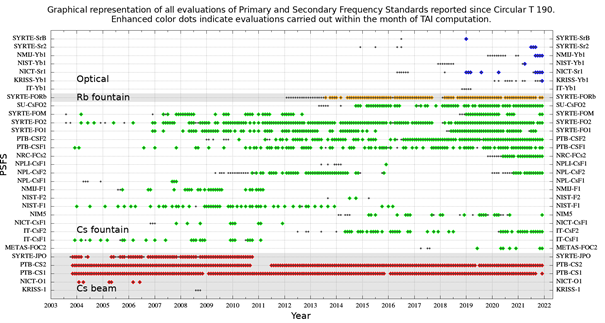
Record number of frequency standards contribute to International Atomic Time
International Atomic Time (TAI) achieves its stability from more than 450 atomic clocks world-wide and its accuracy from a small number of primary and secondary frequency standards which aim at realizing the SI second with the smallest uncertainty. Each month the BIPM publishes, in section 3 of Circular T [1], an estimation of the TAI frequency accuracy as measured by those individual frequency standards, as well as an ensemble average computed by the BIPM. In November 2021, sixteen different frequency standards operated in eleven laboratories contributed to this estimation, including ten Cs fountains, one Rb fountain, one Sr optical lattice and two Yb optical lattice clocks, in addition to the two legacy Cs beams operated by the PTB. This constitutes a record level of participation, both in terms of the number of different standards and the number of different laboratories.
Optical clocks have reached a proven accuracy of order 10−18 in relative frequency, surpassing the present Cs fountains by two orders of magnitude and driving the Consultative Committee for Time and Frequency (CCTF) to initiate work towards a redefinition of the second [2]. The CCTF has set-up a wide-ranging task force of experts, which worked to define a number of mandatory criteria to be achieved before changing the definition. One of the mandatory criteria states that optical standards should regularly contribute to TAI, with a goal of at least three contributions per month, with a total uncertainty not larger than 2 × 10−16. This criterion is intended to ensure that the accuracy of TAI is at least maintained and hopefully improved when the redefinition takes place and that it will be based on a robust set of optical frequency standards. Indeed after redefinition Cs fountains will become secondary standards with enlarged uncertainty while the uncertainty of optical standards will be reduced and it is important to ensure that the overall effect of the change is beneficial to TAI.
In 2021, 13 evaluations of optical frequency standards could be used to calibrate TAI, this is more than twice as many as the total number in the preceding three years (PSFS chart). Furthermore, two of them had a total uncertainty around 2.5 × 10−16, which is close to the requirement set in the criterion for redefinition. While this is only a first step towards achieving one of the mandatory criteria, this shows the strong impetus from NMIs and DIs to operate optical frequency standards and move towards the redefinition. The results show significant progress in the operational capabilities, with optical clock uptime exceeding 90 % in some cases. This allows longer operating period and reduced frequency transfer uncertainty, key factors to achieve contributions of optical standards to TAI with a total uncertainty not larger than 2 × 10−16 as required. Looking at the past history of Cs fountain development (PSFS chart) we expect that a similar trend will occur for optical standards, so that the redefinition of the second could take place in 2030 as in the current CCTF plans.

Sr optical lattice clock (image courtesy of NICT)

Yb optical lattice clock (image courtesy of KRISS)

Yb optical lattice clock (image courtesy of NMIJ)
- https://webtai.bipm.org/ftp/pub/tai/Circular-T/cirthtm/cirt.407.html
- https://www.bipm.org/en/committees/cc/cctf/22-_1-2020
